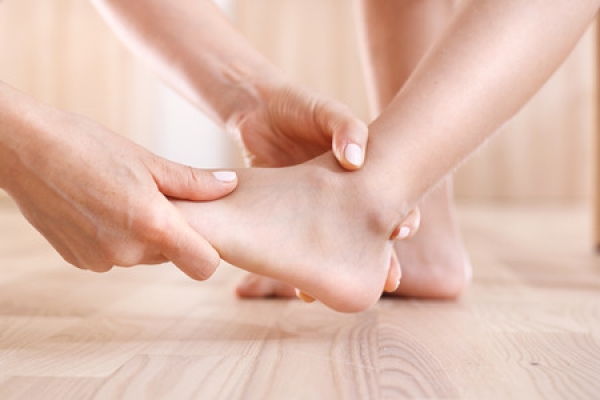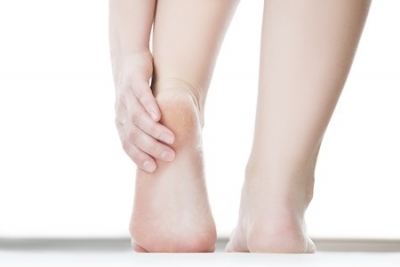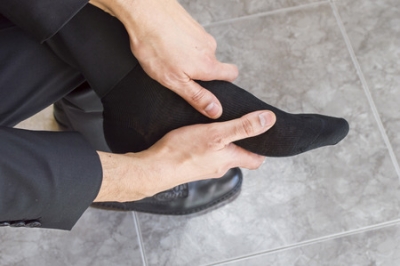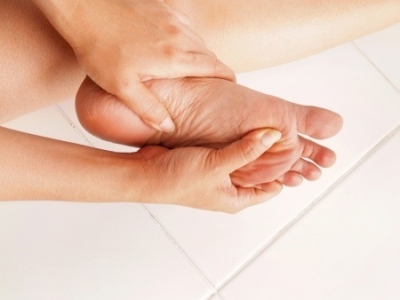Connect With Us
Blogs

Foot Pain (5)
Are you familiar with the condition known as Haglund’s Deformity? At Superior Foot & Ankle Care Center we find that patients have some misconceptions about this disorder which affects the heel. Below are some facts to better familiarize you with this foot problem:
FACT: Haglund’s Deformity is a bony enlargement that develops on the back of your heel. Other signs of this condition are swelling and redness around the enlargement and pain where the Achilles tendon attaches to your heel bone.
FACT: Another name for Haglund’s Deformity is “pump bump.” That’s because pumps with their stiff backs hit the bony enlargement and irritate it, resulting in pain when walking and wearing shoes.
FACT: More women than men get Haglund’s Deformity.
FACT: Although pumps aggravate the bony enlargement, they are not the cause of Haglund’s Deformity. This condition is the result of structural defects, including overly high arches, the tendency to walk on the outside of your heel or a tight Achilles tendon.
FACT: Haglund’s Deformity can only be corrected by surgery. There are, however, a number of conservative measures that can be used to relieve pain and decrease pressure on the bony protrusion. After our podiatrists, Dr. Victoria Foley and Dr. Constance Omelas, examine your heel and order x-rays or other imaging studies to confirm a diagnosis of Haglund’s Deformity a treatment plan can be determined.
FACT: Treatment for pump bump will depend in part on the cause. Heel pads, for example, may be recommended if the cause is high arches or stretching exercises for your calf if the source of the condition is a tight Achilles tendon. Custom orthotics can also be used to correct abnormal foot motion.
FACT: Pain from pump bump can be reduced by icing the bony enlargement. Apply an ice pack wrapped in a thin towel (do not apply ice directly to the skin) for 20 minutes at a time with a 40-minute break in between.
FACT: You can help prevent inflammation of the bony growth by wearing shoes with open backs or those made of soft materials. You should also avoid running on hard surfaces and up hills.
If you have additional concerns about Haglund’s Deformity, contact our Long Beach office by calling: (562) 420-9800.
At Superior Foot & Ankle Care Center we know that tracking down the source of foot pain in children can be challenging. A condition that often affects children between the ages of 8 and 14 is Sever’s Disease, also known as calcaneal apophysitis. Until your child passes through puberty, his or her legs and feet continue to grow and develop. Sometimes the heel bone can grow faster than the tendons and muscles of the leg. This can result in a feeling of tightness and pressure in the heel. The back of the growth plate has a vulnerable spot where new bone growth forms. Continuous stress on the heel caused by running, jumping and wearing cleats can inflame the growth plate. High-risk sports include soccer, football, track, basketball and gymnastics.
Signs and Symptoms
Pain in the bottom of the heel, a loss of flexibility, or a feeling of tiredness in the foot are the primary symptoms of Sever’s Disease. There also may be some swelling in the affected area. Young children, however, may not be able to articulate their symptoms. Look for these signs that heel or other foot pain may be occurring:
- Limping
- Walking on tip toes
- Claiming to be tired and not wanting to play
- Avoiding sports and other physical activities that your child usually enjoys
Getting Relief
Our podiatrists, Dr. Victoria Foley and Dr. Constance Omelas will develop a treatment plan to help relieve pain and inflammation. This will most likely include resting the heel and avoiding sports and activities that aggravate it as well as any of the following:
- Icing the heel
- Anti-inflammatory medications
- Heel cushion inserts or orthotics
- Exercises to stretch and strengthen lower leg muscles and tendons
Sever’s Disease does not have any long-term effects as long as your child takes a break from activities that are putting a strain on the heel and allows the inflammation to go away. It’s important, however, not to ignore signs of foot pain in young athlete’s or encourage them to “play through the pain,” as damaging injuries can then occur.
If you have questions about your child’s foot health, contact our Long Beach office today by calling: (562) 420-9800.
When your heel hurts, we at Superior Foot & Ankle Center know how limiting that can be on your day to day life. When every step is painful it’s difficult to walk, let alone work, shop, take care of children and household tasks or do any of the many other activities we normally take for granted. While resting your foot may temporarily ease heel soreness, permanent relief requires discovery of the source of the pain and developing a treatment plan that will address the root cause. Below are some common reasons for heel pain:
- Plantar fasciitis/heel spurs—this disorder is one of the most frequent reasons why patients experience heel pain. It occurs when the plantar fascia—a long band of tissue that stretches from your toes to your heel on the bottom of your foot—becomes injured or inflamed. If a patient is prone to plantar fasciitis they also have a greater likelihood of developing heel spurs, which are calcium deposits that build up in the heel and cause additional pain.
- The Wrong Shoes—sometimes eliminating heel pain is as simple as changing your shoes. Shoes that don’t provide adequate arch support or that position your foot in an abnormal way can inadvertently put extra pressure on your heel.
- Arch Issues—having flat feet or high arches alters the correct alignment of your feet with heel pain as a possible result.
- Calluses—these patches of hard, dry skin that appear on the surface of your heel are actually a sign of an internal irritation. The excessive pressure put on the heel by wearing high heels, being overweight, an altered gait or even the loss of the natural fat padding on your heel can all cause heel irritation which reveals itself in the callus.
- Nerve Problems—with disorders such as tarsal tunnel syndrome or Baxter neuropathy a compressed nerve in the foot or ankle can produce excruciating pain in the heel. If the pain is felt in both heels there is also a chance that the nerve issue is further up in the body in the spinal column.
Our podiatrists, Dr. Victoria Foley and Dr. Constance Ornelas will need to do a complete examination of your foot, ankle, and heel to diagnose the source of your heel pain. X-rays and other imaging studies may also be ordered. Once a diagnosis is confirmed, the foot doctor will be able to prescribe the correct treatment plan to resolve your heel pain. If you are experiencing pain in your heel, contact our Long Beach office by calling (562) 420-9800 today.
Do you experience a burning or tingling sensation that feels something like an electrical shock on the inside of your ankle bone? What about numbness or shooting pain in that area? If yes, you may be experiencing the symptoms of a condition known as Tarsal Tunnel Syndrome. At Superior Foot & Ankle Care Center we find that these symptoms can manifest in a number of ways. In some patients, they come on suddenly after a particularly strenuous workout session or after a long day of standing. The symptoms may also be experienced just in one spot or extend to the heel, calf, arch, and toes. This can make diagnosis a bit tricky because the symptoms are similar to those of several other podiatric conditions. Our podiatrists, Dr. Victoria Foley and Dr. Constance Ornelas will want to do a complete examination of your foot and ankle, checking for loss of sensation and trying to reproduce the symptoms you experience. Nerve conduction studies and advanced imaging studies may also be ordered.
Tracking Down the Source
The tarsal tunnel is literally a tunnel on the inside of your ankle that houses the posterior tibial nerve along with arteries, veins, and tendons. The tunnel is covered with a thick, protective ligament. Whenever something occurs that causes the nerve to be compressed the above symptoms can result. There are many different reasons for nerve compression:
- Flat feet—fallen arches cause the heel to turn outward which can put a strain on the posterior tibial nerve.
- Crowding—if an abnormal structure such as a ganglion cyst or a bone spur develops in the tunnel or a structure such as a tendon or varicose vein becomes enlarged it takes up more space in the tarsal tunnel, decreasing the amount of room for the nerves and other structures that belong in the tunnel. This causes the nerve to be squeezed or compressed.
- Injury—if you sprain your ankle or sustain another injury to that part of your foot the nerve may be compressed due to swelling or inflammation that occurs from the injury.
- Disease—certain diseases, such as diabetes and arthritis, also have swelling associated with them and will produce compression.
Once the foot doctor confirms a diagnosis of tarsal tunnel syndrome and determines the source the appropriate treatment can be prescribed. Left untreated the nerve damage can become permanent. So don’t delay—if you have symptoms, contact our Long Beach office at 562-420-9800.
One of the complaints that patients sometimes bring to Superior Foot & Ankle Care Center is a burning sensation in their feet. In addition to examining your feet, our podiatrists, Dr. Victoria Foley and Dr. Constance Omelas will want to get a complete medical history. If you are over the age of 50, a burning feeling in your feet is more common, especially if you’ve walked a long distance or spent many hours standing. The foot doctor may suggest some ways to relieve the burning, such as:
- Not standing for long periods of time or, if you have a day where you need to be on your feet, at least take breaks and put your feet up for a few minutes every hour
- Make sure your shoes fit properly and are not too snug; the design of the shoe should allow for air circulation
- Choose breathable materials for shoe and socks—synthetics can prohibit feet from breathing and make burning more likely
- Try cushioned insoles for increased comfort
- Soak tired feet in a foot bath to relieve burning
A Word of Caution
Sometimes a burning sensation in your feet may be the result of a more serious podiatric problem. For example, a structural problem may require an orthotic device to shift pressure away from the troubled area and alleviate the burning. Other possibly serious reasons for burning feet include:
- A Neuroma or Tarsal Tunnel Syndrome
- Diabetes
- Thyroid Disorder
- Obesity
- Alcohol Abuse
If burning feet is a problem that you endure consistently, you should make an appointment to get your feet evaluated at our Long Beach office. Many times your feet can be an early warning system for systemic problems in your body and it’s better to be safe than sorry. Contact us at 562-420-9800 and find out what’s behind your burning feet.





